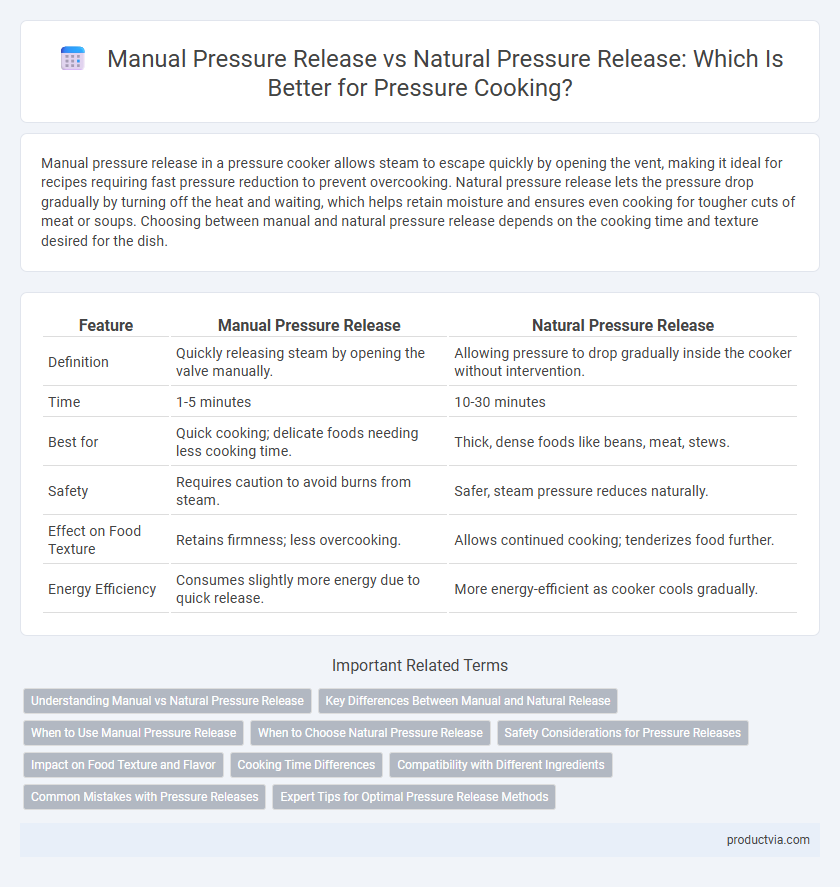Manual pressure release in a pressure cooker allows steam to escape quickly by opening the vent, making it ideal for recipes requiring fast pressure reduction to prevent overcooking. Natural pressure release lets the pressure drop gradually by turning off the heat and waiting, which helps retain moisture and ensures even cooking for tougher cuts of meat or soups. Choosing between manual and natural pressure release depends on the cooking time and texture desired for the dish.
Table of Comparison
| Feature | Manual Pressure Release | Natural Pressure Release |
|---|---|---|
| Definition | Quickly releasing steam by opening the valve manually. | Allowing pressure to drop gradually inside the cooker without intervention. |
| Time | 1-5 minutes | 10-30 minutes |
| Best for | Quick cooking; delicate foods needing less cooking time. | Thick, dense foods like beans, meat, stews. |
| Safety | Requires caution to avoid burns from steam. | Safer, steam pressure reduces naturally. |
| Effect on Food Texture | Retains firmness; less overcooking. | Allows continued cooking; tenderizes food further. |
| Energy Efficiency | Consumes slightly more energy due to quick release. | More energy-efficient as cooker cools gradually. |
Understanding Manual vs Natural Pressure Release
Manual pressure release in pressure cookers involves rapidly releasing steam by opening the valve, which quickly reduces internal pressure and stops cooking immediately, ideal for vegetables and delicate foods. Natural pressure release allows the pressure to decrease gradually as the cooker cools, promoting tenderization and flavor development for tougher meats and stews. Choosing between manual and natural release depends on the food type and desired texture, optimizing both cooking time and results.
Key Differences Between Manual and Natural Release
Manual pressure release involves quickly opening the valve to release steam immediately after cooking, which is ideal for recipes requiring precise timing or quick stopping. Natural pressure release allows the pressure to drop gradually on its own, preserving moisture and tenderness in foods like stews and braises. The key differences lie in the speed of pressure reduction and the impact on texture and cooking continuation.
When to Use Manual Pressure Release
Manual pressure release is ideal for quick-cooking foods such as vegetables, seafood, and delicate items that can overcook if left under pressure too long. It is also preferred when you need to stop the cooking process immediately to preserve texture and prevent mushiness. Use manual pressure release to reduce pressure rapidly after short cooking cycles or when recipes specify rapid depressurization.
When to Choose Natural Pressure Release
Natural pressure release is ideal for cooking foods that benefit from gradual cooling, such as large cuts of meat, beans, and stews, allowing flavors to develop fully and preventing splattering. It helps retain moisture and tenderness by letting the pressure drop slowly without sudden temperature changes. Use natural release when recipes call for extended resting time or when delicate ingredients might break apart with rapid depressurization.
Safety Considerations for Pressure Releases
Manual pressure release in pressure cookers involves carefully turning the valve to release steam quickly, requiring cautious handling to avoid burns from hot steam and sudden pressure changes. Natural pressure release allows pressure to decrease slowly inside the cooker as it cools, minimizing the risk of hot liquid splatters and preserving food texture but taking longer. Safety considerations prioritize using natural release for dense foods to prevent accidents, while manual release suits recipes needing immediate pressure drop, always ensuring hands and face remain clear of escaping steam.
Impact on Food Texture and Flavor
Manual pressure release rapidly reduces pressure, preserving crisp textures in vegetables and preventing overcooking, ideal for delicate ingredients. Natural pressure release allows gradual cooling, enhancing flavor development by retaining juices and tenderness in meats and stews. Choosing between methods depends on desired texture outcomes and the type of food being cooked.
Cooking Time Differences
Manual pressure release in pressure cookers significantly reduces cooking time by quickly releasing steam, allowing immediate access to food, whereas natural pressure release extends cooking time as the pressure gradually decreases without intervention. Manual release is ideal for recipes needing quick stop to prevent overcooking, while natural release suits dishes requiring continued gentle cooking or tenderizing. Understanding these methods enables precise control over cooking duration and food texture in pressure cooking.
Compatibility with Different Ingredients
Manual pressure release allows for quick reduction of pressure, making it ideal for delicate ingredients like vegetables and seafood that require precise cooking times to avoid overcooking. Natural pressure release is better suited for tougher cuts of meat and legumes, as the gradual pressure decrease promotes tenderization and thorough cooking. Choosing the appropriate release method ensures optimal texture and flavor compatibility with a wide range of ingredients.
Common Mistakes with Pressure Releases
Common mistakes with pressure releases in pressure cookers include prematurely using manual pressure release, which can cause food to splatter or undercook, especially with starchy or foamy ingredients. Natural pressure release is often preferred for dense meats and stews to allow gradual cooking and prevent tough textures, but neglecting to time it correctly can lead to overcooking or extended waiting periods. Understanding the specific recipe requirements and pressure cooker model guidelines helps avoid safety risks and ensures optimal texture and flavor.
Expert Tips for Optimal Pressure Release Methods
Manual pressure release rapidly reduces the pressure by turning the valve to vent steam, ideal for delicate foods like vegetables to prevent overcooking. Natural pressure release allows the cooker to cool down gradually, enhancing flavor retention and tenderness in meats and beans. Experts recommend using manual release for quick-cooking ingredients and natural release for dense, slow-cooked recipes to achieve optimal texture and taste.
Manual pressure release vs Natural pressure release for pressure cooker Infographic

 productvia.com
productvia.com